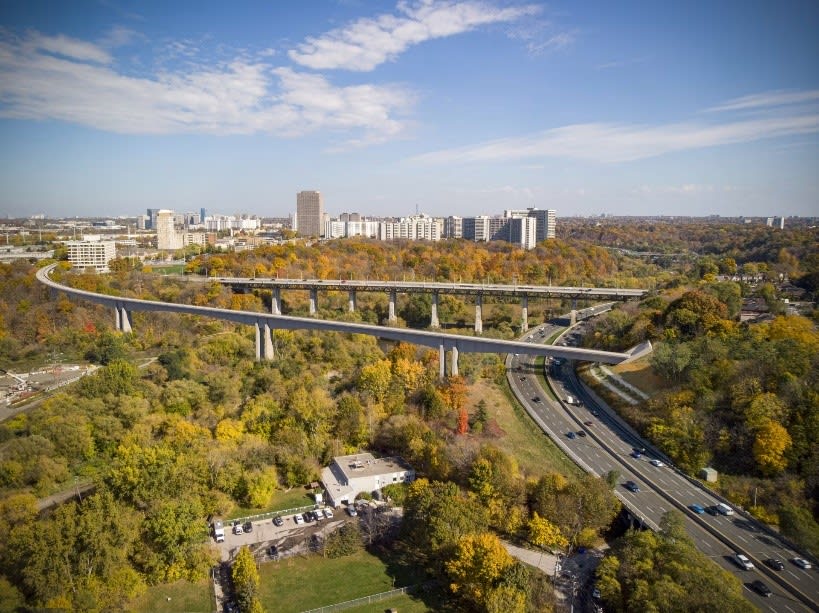Share
The story behind the three bridges of the future Ontario Line
These functional and elegant crossings will transform Toronto’s cityscape.
Jul 24, 2024
Running from Exhibition Place in the west, through the downtown core, over to the east end, and north to Thorncliffe Park and Flemingdon Park, the future Ontario Line will bring 15 new stations to Toronto, and three landmark bridges that will transform the cityscape.
These include the Lower Don Bridge, which will cross the Don River in the West Don Lands and Riverside neighbourhoods, and two Don Valley bridges, which will carry trains across the Don Valley in the north segment of the Ontario Line.
While all three crossings embrace a clean, simple, functional and elegant design approach, each bridge was developed with its specific site’s requirements in mind.
“They look very different, but there is a sound reason for that,” said John Potter, senior manager subways sponsor at Metrolinx. “The impulse driving the designs starts with the optimal structural solution for each bridge.”
The Don Valley Crossings
The future Don Valley Crossing Bridge is a balanced cantilever design that will be about 34 to 38 metres tall at its highest point. The first significant new elevated crossing of the Don Valley since the Leaside Bridge was constructed in 1927, it will carry Ontario Line trains between the Minton Place tunnel portal and Thorncliffe Park.
Conceptual rendering of future Don Valley Crossing bridge. (Metrolinx image)
A second bridge, the West Don Crossing Bridge, features the same balanced cantilever construction method and will connect the Thorncliffe Park and Flemingdon Park guideways and stations.
Both bridges have been designed with long spans between support columns, or piers, which will mean minimized impacts during construction as well as reduced long-term impacts once construction is completed and the site is re-naturalized.
"We wanted something very slender and elegant, like ribbons crossing the valley,” said Potter. “We aimed to minimize the visual clutter that often mars the beauty of civic structures. For example, we have integrated the downspouts into the piers, so that it does not appear tacked on.”
The resulting designs are impactful and complement their location rather than compete with it. "The valley itself is the feature,” said Potter.
The Lower Don Bridge
The Lower Don Bridge will have a steel network tied arch structure, which will allow it to clear span over both the Don River and the Don Valley Parkway, meaning that piers won’t have to be introduced either in the river or the parkway.
"Another benefit of this arched bridge design is that it's also quite a beautiful structure that can become a marker of the east side of downtown in much the same way that the Humber Bay Arch Bridge is a visual marker when you're approaching the downtown from the west,” said Potter.
"We also included an aesthetic lighting scheme so that you would see this bridge at night – the form would always be legible to people passing by and looking at it.”
Rendering of the future Ontario Line bridge over the lower Don River. (Metrolinx image)
Additionally, the materials and finishes for the Lower Don Bridge were chosen for their longevity and appropriateness for the site. To minimize corrosion and repel dirt, for example, a multi-layered, custom coating will be applied to all steel surfaces.
"The Don Valley Parkway, like all highways, kicks up a lot of salt spray or salt fog in the winter which is extremely corrosive,” said Potter.
Connecting communities and improving transit
Together, these three bridges will transform Toronto’s urban landscape, and become defining landmarks of the Ontario Line.
“These bridges have to be functional, but we also are very cognizant about their place in the city, and we spent a lot of time sculpting elements on them to get the details right,” said Potter.
Carrying Ontario Line trains across the Don River and the Don Valley, they will play a role in connecting communities across the city, from downtown to the West Don Lands to Flemingdon Park.
The future Ontario Line will also make it faster and easier to travel within Toronto and beyond.
A trip from end-to-end of the 15.6-kilometre subway line will take less than 30 minutes, instead of the 70 minutes it takes on transit today. It will also put 227,500 more people within walking distance to transit, and mean 28,000 fewer car trips every day.
by Truc Nguyen Senior Editorial Content Producer
